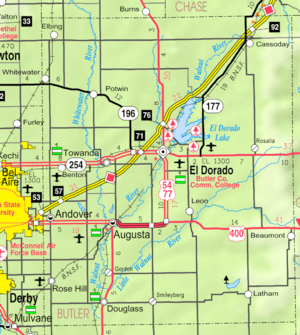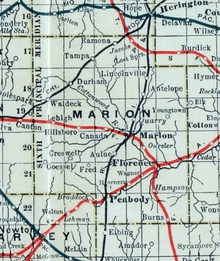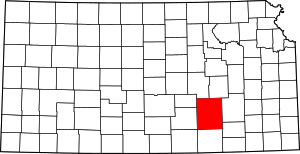Elbing, Kansas
Elbing is a city in Butler County, Kansas, United States. It is named after the city Elbląg (German: Elbing) in northern Poland, formerly Prussia. As of the 2010 census, the city population was 229.[7] It is located about 10.7 miles east of Interstate 135 in Newton, along the Union Pacific Railroad.
Elbing, Kansas | |
|---|---|
 Location within Butler County and Kansas | |
 KDOT map of Butler County (legend) | |
| Coordinates: 38°3′15″N 97°7′38″W | |
| Country | United States |
| State | Kansas |
| County | Butler |
| Founded | 1887 |
| Incorporated | 1919[1] |
| Named for | Elbląg |
| Government | |
| • Type | Mayor–Council |
| • Mayor | Clinton Clark |
| Area | |
| • Total | 0.17 sq mi (0.45 km2) |
| • Land | 0.17 sq mi (0.45 km2) |
| • Water | 0.00 sq mi (0.00 km2) |
| Elevation | 1,440 ft (440 m) |
| Population | |
| • Total | 229 |
| • Estimate (2019)[4] | 226 |
| • Density | 1,313.95/sq mi (507.57/km2) |
| Time zone | UTC-6 (CST) |
| • Summer (DST) | UTC-5 (CDT) |
| ZIP code | 67041 |
| Area code | 316 |
| FIPS code | 20-20050[5] |
| GNIS ID | 0478025[6] |
| Website | elbingks.com |
History
Early history
For many millennia, the Great Plains of North America was inhabited by nomadic Native Americans. From the 16th century to 18th century, the Kingdom of France claimed ownership of large parts of North America. In 1762, after the French and Indian War, France secretly ceded New France to Spain, per the Treaty of Fontainebleau.
19th century

In 1802, Spain returned most of the land to France. In 1803, most of the land for modern day Kansas was acquired by the United States from France as part of the 828,000 square mile Louisiana Purchase for 2.83 cents per acre.
In 1854, the Kansas Territory was organized, then in 1861 Kansas became the 34th U.S. state. In 1855, Butler County was established within the Kansas Territory, which included the land for modern day Elbing.
In 1887, the Chicago, Kansas and Nebraska Railway built a branch line north–south from Herington through Elbing to Caldwell.[8] It foreclosed in 1891 and was taken over by Chicago, Rock Island and Pacific Railway, which shut down in 1980 and reorganized as Oklahoma, Kansas and Texas Railroad, merged in 1988 with Missouri Pacific Railroad, merged in 1997 with Union Pacific Railroad. Most locals still refer to this railroad as the "Rock Island".
The track passed through the land of Jacob W. Regier in section 17 of the Fairmount Township in Butler county in south central Kansas. The Regiers sold 80 acres (320,000 m2) of section 17 to the Elbing Town Company for $5,000. The 1/4 mile by 1/2 mile plot ran along the west side of the CK&NR tracks. The railroad wanted to call the town Regier but Mr. Regier suggested three other possibilities: Elbing, Danzig and Marienburg, all cities in Prussia where he had lived. Elbing was chosen. The town was founded May 18, 1887. Within a few months people began to build houses and businesses in Elbing. By November four passenger trains (two in each direction) served Elbing. The trains also provided mail delivery and pick-up twice daily.
A post office was established in Worth (an extinct town) on March 16, 1886, but it was moved to Elbing on November 2, 1887.[9][10]
School district 160 for the Elbing community was established in 1887 and provided public education for several local primary school students. The original frame building was replaced by a red brick building in 1919. The brick building stands vacant today and has not been used for classes for about twenty years. Now, Elbing students who attend a public school travel to nearby Whitewater, Kansas for grades K-8 or to nearby Burns, Kansas for grades 9-12.
The Methodist Episcopal Church, Elbing's first church, was built in 1905, but the church disbanded in 1937. The Missionary Church, built in Elbing in 1910, was used until the 1960s when the congregation moved to nearby Newton, Kansas. The building was razed in 1975. The Zion Mennonite Church, which was built in Elbing in 1924, is the only church which remains in town.[11]
Elbing grew slowly. By 1895 it had a few businesses and 50 residents. By the turn of the century telephone service was available to the residents of Elbing on a party-line basis–four families for each telephone line. By 1910 the population had reached 100 and the town had several businesses: general store (with a post office), hardware store, implement store, bank, blacksmith shop, lumber yard, barber shop, cafe, and hotel. The town also had a doctor. Electricity did not come to Elbing until 1929 and residents had to provide their own water from wells or cisterns until the city installed a citywide water system in 1967. The city sewer system was installed in 1972. Until then each residence had its own septic tank.
In 1919 the first of several oil wells were drilled near Elbing. As a result of the oil boom, Elbing grew dramatically for a brief time. Although the town's population increased for a few years, the new residents had little lasting effect upon the town. The oil field rapidly declined and a fire destroyed much of Elbing in 1933. Although new residences were eventually rebuilt, Elbing never regained its businesses. For several decades downtown Elbing included only a grocery/hardware store, a gas station/garage, a post office, and a grain elevator. Elbing's grocery/hardware store closed a little over a year ago. Today the garage and grain elevator are the only downtown businesses.
In 1946, Berean Academy was founded at the south end of Elbing.[12] Although it began with fifteen students in grades nine and ten, it quickly expanded to include grades nine through twelve. By the 1970 Berean Academy had an enrollment of 300 students. Today, Berean Academy includes gradesK-12 and has an enrollment of about 260 students. The academy was established as a Mennonite school, but in 1966 it dropped its Mennonite distinctives to become an interdenominational Christian school. Berean Academy, probably more than any business or group of people, has sustained the life of Elbing. Although the town has several residents who are retired or are employed in nearby towns, a significant number of families reside in Elbing because of their connection to Berean Academy. Some live here because they teach at the school and others make it their home here so that their children can attend Berean Academy.
Today Elbing has about 350 residents. It still has only three north and south streets (Main, Regier, and Johnson); and with the exception of about 20 acres (81,000 m2) that was added at the south end by annexing Berean Academy, it is still 1/4 mile wide and 1/2 mile long. The area surrounding Elbing is mostly devoted to grain farming–primarily red winter wheat and sorghum grain. Nearby farms also raise a few cattle and hogs. During the last three decades almost forty houses have been built in Elbing, so only a few of its original lots remain unoccupied. The town still has a small Post Office and is in the process of building its first fire station. Until the fire station is in operation, Elbing continues to depend upon the help of volunteer firemen and the fire protection services of nearby Newton, Kansas.
In 1961, Frederic Remington High School was built immediately north of Brainerd. Leading up to this new school, Whitewater, Potwin, Brainerd, Elbing, Furley, Countryside, and Golden Gate schools merged to form a joint rural high school. Heated opposition between Whitewater and Potwin occurred during the discussion for the location of the new high school. Rural voters pushed for a centralized location in neither town. A public vote was passed to build the new school near Brainerd.[14]
Geography
Elbing is located at 38°3′15″N 97°7′38″W (38.054115, -97.127119).[15] According to the United States Census Bureau, the city has a total area of 0.19 square miles (0.49 km2), all of it land.[16]
Climate
The climate in this area is characterized by hot, humid summers and generally mild to cool winters. According to the Köppen Climate Classification system, Elbing has a humid subtropical climate, abbreviated "Cfa" on climate maps.[17]
Demographics
| Historical population | |||
|---|---|---|---|
| Census | Pop. | %± | |
| 1920 | 230 | — | |
| 1930 | 110 | −52.2% | |
| 1940 | 101 | −8.2% | |
| 1950 | 98 | −3.0% | |
| 1960 | 105 | 7.1% | |
| 1970 | 128 | 21.9% | |
| 1980 | 175 | 36.7% | |
| 1990 | 184 | 5.1% | |
| 2000 | 218 | 18.5% | |
| 2010 | 229 | 5.0% | |
| Est. 2019 | 226 | [4] | −1.3% |
| U.S. Decennial Census | |||
In 2014, Elbing was ranked the most conservative city in Kansas.[18]
2010 census
As of the census[3] of 2010, there were 229 people, 73 households, and 63 families residing in the city. The population density was 1,205.3 inhabitants per square mile (465.4/km2). There were 77 housing units at an average density of 405.3 per square mile (156.5/km2). The racial makeup of the city was 99.6% White and 0.4% from two or more races. Hispanic or Latino of any race were 0.4% of the population.
There were 73 households, of which 47.9% had children under the age of 18 living with them, 75.3% were married couples living together, 6.8% had a female householder with no husband present, 4.1% had a male householder with no wife present, and 13.7% were non-families. 11.0% of all households were made up of individuals, and 5.5% had someone living alone who was 65 years of age or older. The average household size was 3.14 and the average family size was 3.38.
The median age in the city was 30.8 years. 36.2% of residents were under the age of 18; 4.8% were between the ages of 18 and 24; 20.5% were from 25 to 44; 21.4% were from 45 to 64; and 17% were 65 years of age or older. The gender makeup of the city was 52.0% male and 48.0% female.
2000 census
As of the census[5] of 2000, there were 218 people, 73 households, and 62 families residing in the city. The population density was 1,275.0 people per square mile (495.1/km2). There were 77 housing units at an average density of 450.3 per square mile (174.9/km2). The racial makeup of the city was 94.95% White, 2.75% African American, and 2.29% from two or more races. Hispanic or Latino of any race were 2.75% of the population.
There were 73 households, out of which 43.8% had children under the age of 18 living with them, 79.5% were married couples living together, 5.5% had a female householder with no husband present, and 13.7% were non-families. 11.0% of all households were made up of individuals, and 6.8% had someone living alone who was 65 years of age or older. The average household size was 2.99 and the average family size was 3.27.
In the city, the population was spread out, with 35.8% under the age of 18, 3.2% from 18 to 24, 22.9% from 25 to 44, 18.3% from 45 to 64, and 19.7% who were 65 years of age or older. The median age was 38 years. For every 100 females, there were 98.2 males. For every 100 females age 18 and over, there were 89.2 males.
The median income for a household in the city was $45,417, and the median income for a family was $49,375. Males had a median income of $40,750 versus $16,250 for females. The per capita income for the city was $16,513. None of the families and 0.8% of the population were living below the poverty line.
Government
The Elbing consists of a mayor and five council members. The council meets once a month.[1]
- City Hall, 215 Main St.
Education
Public
The community is served by Remington USD 206 public school district. The Remington High School mascot is a Bronco.
- Frederic Remington High School at 8850 NW Meadowlark Road, north of Brainerd.
- Remington Middle School at 316 E Topeka Street in Whitewater.
- Remington Elementary School at 200 E Ellis Avenue in Potwin.
Private
- Berean Academy, 201 South Elbing Road in Elbing.
Media
Print
- The Newton Kansan, regional newspaper from Newton.
- The Wichita Eagle, major regional newspaper from Wichita.
Radio
Elbing is served by numerous radio stations of the Wichita-Hutchinson listening market area,[19] and satellite radio. See Media in Wichita, Kansas.
Television
Elbing is served by over-the-air ATSC digital TV of the Wichita-Hutchinson viewing market area,[20] cable TV, and satellite TV. See Media in Wichita, Kansas.
Infrastructure
Transportation
The Oklahoma Kansas Texas (OKT)[21] line of the Union Pacific Railroad runs north–south through the east side of the city. Elbing had a depot when the city was founded but was removed in the 1970s.
Utilities
- Internet
- Wireless is provided by Pixius Communications.
- Satellite is provided by HughesNet, StarBand, WildBlue.
- TV
- Satellite is provided by DirecTV, Dish Network.
- Terrestrial is provided by regional digital TV stations.
- Telephone
- Landline is provided by AT&T Inc.
- Electricity
- City is provided by Westar Energy.
- Rural is provided by Butler REC.
- Natural Gas
- Service is provided by Kansas Gas Service.
- Water
- City is provided by Harvey County RWD #1, billed by City of Elbing.
- Rural is provided by Harvey County RWD #1 (map) and Butler County RWD #7 (map).
- Sewer
- Service is provided by City of Elbing.
- Trash
- Service is provided by Waste Connections, billed by City of Elbing
See also
- Fairmount Township, Butler County, Kansas (location of Elbing)
- Berean Academy
- Frederic Remington High School
References
- "Information about City of Burns". The League of Kansas Municipalities. Retrieved January 25, 2019.
- "2019 U.S. Gazetteer Files". United States Census Bureau. Retrieved July 24, 2020.
- "U.S. Census website". United States Census Bureau. Retrieved July 6, 2012.
- "Population and Housing Unit Estimates". United States Census Bureau. May 24, 2020. Retrieved May 27, 2020.
- "U.S. Census website". United States Census Bureau. Retrieved January 31, 2008.
- "US Board on Geographic Names". United States Geological Survey. October 25, 2007. Retrieved January 31, 2008.
- "2010 City Population and Housing Occupancy Status". U.S. Census Bureau. Retrieved March 6, 2011.
- "Rock Island Rail History". Archived from the original on 2011-06-19. Retrieved 2010-08-01.
- "Kansas Post Offices, 1828-1961 (archived)". Kansas Historical Society. Archived from the original on October 9, 2013. Retrieved June 5, 2014.
- "Kansas Post Offices, 1828-1961, page 2 (archived)". Kansas Historical Society. Archived from the original on October 9, 2013. Retrieved June 5, 2014.
- Zion Mennonite Church; Global Anabaptist Mennonite Encyclopedia Online.
- Berean Academy; Global Anabaptist Mennonite Encyclopedia Online.
- Much of this information was found in Elbing-Next Stop which was written by Arnold and Helen Regier and published in 1994
- USD 206 History
- "US Gazetteer files: 2010, 2000, and 1990". United States Census Bureau. February 12, 2011. Retrieved April 23, 2011.
- "US Gazetteer files 2010". United States Census Bureau. Archived from the original on January 12, 2012. Retrieved July 6, 2012.
- Climate Summary for Elbing, Kansas
- Map of the Most Liberal And Most Conservative Towns In Each State; Business Insider; June 21, 2014.
- Wichita-Hutchinson Radio market.
- Wichita-Hutchinson TV market.
- "UP Railroad Common Line Names" (PDF). Union Pacific Railroad. Retrieved August 2, 2010.
Further reading
External links
| Wikimedia Commons has media related to Elbing, Kansas. |
- City
- Maps
- Elbing City Map, KDOT
- Topo Map of Elbing / Newton area, USGS
- Butler County Maps: Current, Historic, KDOT
